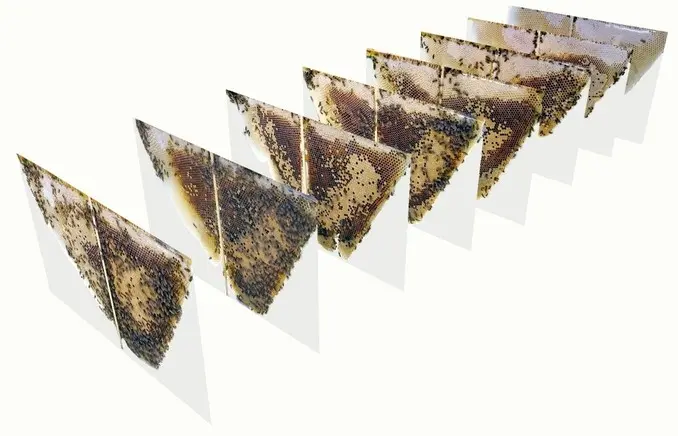Unveiling the Hive Harmony

Hello Bee Enthusiasts! ✨ Let’s explore the secret world of bees and their magnificent nests!
Nestled in their own natural comb, these little architects create wonders beyond just a space for food and brood. Their hive structure is a masterpiece, enhancing colony function and ensuring their survival. Ready to delve into the bee ballet?
Hive Decisions
Before a colony decides to swarm, they’re like real estate agents evaluating the perfect hive spot. Size, location, entrance orientation—it all matters. Bees don’t just stop at choosing a home; they continue making decisions, crafting a nest that’s a blueprint for survival.
Nest Building Chronicles
In the world of top bar hives, swarms cluster in the hive’s front third, starting their comb magic on bars 3 to 5. The building dance begins, guided by the cluster’s size. Combs extend horizontally, a few vertically below the cluster limits. As more vertical comb is built, the broodnest environment becomes a coordinated effort, freeing bees to work horizontally.
Once a few combs are long enough for new brood, vertical comb building becomes uniform, extending beyond the cluster. Bees strategically create large storage and drone cells along the top bars, transitioning quickly into larger worker cells. The dance of comb creation is a visual symphony, especially near the hive entrance.
Shifting Focus

-Peek into the natural broodnest cross-section.
Bees are master shifters when it comes to comb focus. Sometimes, comb extends horizontally, and then, in a twist, bees move towards the hive’s front, working comb vertically. These shifts aren’t just about nectar flow; it’s a dance of brilliance. Broodnest structure remains consistent, even when bees shift focus, showcasing the hive’s timeless wisdom.
The Three-Part Harmony
1. Broodnest
Straight comb near the entrance, spaced at 1 1/4 inches, is the heart of brood rearing. Cells gradually taper from larger at the top bar to smaller at the comb’s bottom, creating a structured dance of nature.
2. Broodnest Core
Near the entrance, a small cell size area remains open for brood rearing. This is the broodnest core, a vital space where bees:
- detect and remove broodnest peers
- conserve heat and humidity
- efficiently use scarce late winter resources
3. Honey Storage Area

-Typical honey storage area comb.
Away from the entrance, combs quickly transform into a honey storage area. Thicker, wider-spaced combs, drone-sized cells, and a bit of chaotic orientation—nature’s storage brilliance in action!
Oops Moments
1. The Bees’ Dilemma

-Reworked comb.
Sometimes, a comb rebels against the typical broodnest structure. Top bar 7 showcased drone-sized cells where they shouldn’t be. Bees attempted a rework, but the comb remained unfinished. A delicate dance indeed!
2. The Beekeeper’s Lesson
Comb management is an art. Bees balance many factors when building a broodnest, but they don’t have a mechanism for:
- Rotations.
- Shifts.
- Insertions backwards.
Typical hive management mixes up a broodnest. When I messed up the broodnest structure in the top bar hives, they quickly developed parasitic mite syndrome, requiring treatments for survival. Rearranging comb to mimic a natural broodnest structure led to mites in those hives, but without developing PMS.
That’s the importance of broodnest structure—mess it up, and you’ve messed up hive function and health.
-Buzzingly Yours, D 🐝🤠
